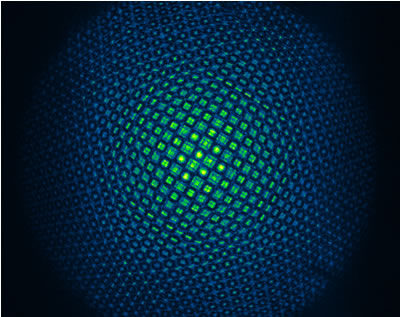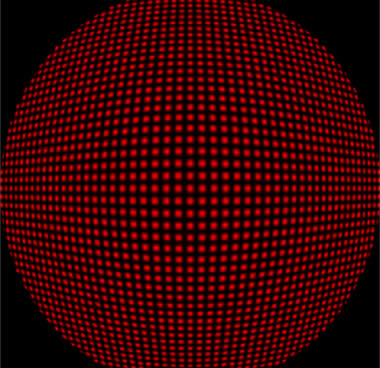This image was obtained from a quadri-lateral shift interferometer1 for analyzing a light beam exhibiting a defect very well known to opticians: spherical aberration.

copyright © Phasics 2007 - Tous droits réservés
Analysis by multi-lateral shift interferometry of a light beam exhibiting a spherical aberration.
Spherical aberration is characteristic of a spherical mirror, which is easy to make instead of a parabola, for observing a source at infinity. It has thus been described and studied since the eleventh century by Arab scientists, Ibn Sahl in particular.
This interferometer, invented at Onera, is currently used for checking hyper-intensity lasers2, and has regularly contributed to surpassing power frontiers since 2000. It is thus installed on laser chains at:
- Luli [laboratory for the use of intense lasers] of the Ecole Polytechnique in Palaiseau
- Cuos [Center for Ultrafast Optical Science] at the University of Michigan
- Lawrence Livermore National Lab, University of California
- Rutherford Lab in the UK
- and in some ten countries worldwide.
The interferogram is analyzed by harmonic analysis (Fourier technique) by which the shift of each of the spots with respect to an origin position (perfect beam) can be referenced. Considering the very large amplitude of the aberration analyzed here, the grid is especially deformed, which gives it this Vasarely-style abstract character.

copyright © Phasics 2007 - Tous droits réservés
Interferogram of a light beam without aberration defect.
Images: Phasics company [www.phasics.com]
Text: Jérôme Primot, researcher in Onera's Theoretical and Applied Optics department
Lexique
- Interféromètre à Décalage Quadri-Latéral
Instrument d'analyse optique récemment développé par l’Onera. Son principe, proposé en 2000, est basé sur l’utilisation de quatre répliques de l’onde lumineuse à analyser, décalées et légèrement inclinées, de l’onde incidente. La figure d’intensité générée par l’interférence de ces quatre répliques est simplement composée de taches brillantes disposées selon un maillage cartésien. Si la phase de l’onde répliquée n’est pas plane, l’interférogramme subira alors des déformations qui pourront être étudiées pour obtenir les dérivées de la surface d’onde incidente. Les dérivées ainsi obtenues pourront alors être numériquement combinées afin de reconstruire la surface d’onde analysée.
A quoi ça sert ?
- Laser hyper-intense
Un laser hyper-intense est une source laser impulsionnelle qui permet de fournir des puissances très importantes (du Gigawatt au Petawatt3), souvent utilisée pour la métrologie ou l'analyse de la matière. [Les pointeurs stylo laser ont des puissance de l'ordre du mW] - Giga, Peta
Giga=109 soit un milliard, Peta=1015 soit un million de milliard




